|
|
| The East of England's Biodiversity Habitat Achievements & Targets 1996 - 2015 |
|
Habitats are central to biodiversity.
As biodiversity is globally threatened it is critical habitats are not merely maintained, but proactively managed and, ideally, expanded.
This brochure is aimed at decision-makers in local government, both officers and members, at environmental organisations, as well as at landowners, their managers and active communities. For anyone interested in delivering biodiversity throughout the East of England this brochure provides the information they will need to do so.
In it we outline the habitat targets we have set ourselves to improve the environment in the East of England, as well as demonstrate our achievements to date. We do this with a view to engaging better with stakeholders and communities so as to influence policy and trigger far more local action.
Habitats and species
While on the ground this interrelationship seems complex, in theory it is straightforward - species rely on habitats. Thus improving species distribution and numbers will translate directly into enhanced biodiversity. In turn, this richer biodiversity strengthens the capacity of ecosystems to deliver more benefits to people.
Habitat challenges
But the pressures on the East of England's habitats are very real:
- Climate change looks set to have a massive and growing influence
- Population growth is increasing encroachment
- Infrastructure growth arising from improving economy, threatens yet more of the landscape
- Water resources - both quantity and quality issues threaten survival
- Financial context - tthe spending review and subsequent funding limitations means the ability to respond is constrained
- Societal preferences - alterations in behaviour are impacting on sites
This combination of factors will help to indicate where best to apply effort to counteract these pressures and the opportunities for future developments.
As habitats can both directly and indirectly deliver vital benefits to us all, the improvement of habitats should not be confined to conservation specialists alone. For the Forum to succeed in helping to save biodiversity it needs to encourage many other decision-makers to participate in the habitat protection, maintenance and creation process. Only in this way will the Forum fulfil its environmental aspirations in the East of England.
A term embracing the variety of life on Earth. Biodiversity is essential for sustaining the natural living systems or ecosystems that provide us with food, fuel, health, wealth, and other vital services.
Hide
This refers to qualitative functions of natural non-produced assets of land, water and air (including related ecosystems) and their biota. Experts currently recognise four categories of ecosystem services. The following lists provides samples of each type:
Provisioning services
- food (including seafood and game), crops, wild foods, and spices
- water
- pharmaceuticals, bio-chemicals, and industrial products
- energy (hydropower, biomass fuels)
- carbon sequestration and climate regulation
- waste decomposition and detoxification
- purification of water and air
- crop pollination
- pest and disease control
- nutrient dispersal and cycling
- seed dispersal
- primary production
- cultural, intellectual and spiritual inspiration
- recreational experiences (including ecotourism)
Hide
The East of England is likely to experience the most extreme effects of climate change in the country. Consequently biodiversity here will be particularly at risk. Rises in sea levels and risks of seasonal flooding will lead to inundation; by contrast many parts of the East of England will also be at risk of water shortages (see entry on Water resources). As a result the range of some important species may be constricted, while some pest species may thrive.
Hide
As a result of economic growth the East of England population is expected to receive large numbers of incomers over the next 20 years and is consequently set to experience unprecedented growth in housing, farming and associated infrastructures. Consequently all types of habitat are under threat.
Hide
Infrastructure expansion:
Business activity ranging from industrialisation to services such as tourism and entertainment are expected to continue to expand throughout the East of England. Harnessed to this expansion will be a concomitant trend towards urbanisation.
These twin drivers will demand considerable infrastructure growth in terms of water supply and improved transport links that, in turn, will lead to more and more pressure on water resources and natural ecosystems.
Hide
This term refers to sources of water that are useful to humans and the ecosystem. Only 3% of all water on the planet is fresh. Of this over 2/3rds is tied up in glaciers and the icecaps, with virtually another third in ground water and less than 1% on the surface or in the air. This renewable resource is however steadily depleting.
Increasingly in the East of England human demand for water is threatening to exceed supply. Climate change, population growth, expanding business activity and increasing urbanisation are all placing this vulnerable freshwater asset under ever-greater stress.
Hide
The need to reduce public spending in the UK is expected to limit the opportunities to continue to protect and develop the environment across the East of England. In order to contend with these tougher circumstances and respond to growing pressures on the environment a measure of prioritisation will need to be applied.
Hide
Societal preferences:
A number of factors influencing society preferences are having an impact on East of England habitats.
The health agenda is undoubtedly giving rise to increasing numbers of people accessing the countryside. If channeled correctly this is not a problem. However, in some cases where vulnerable BAP species are involved, this increased access can threaten their future.
The trend for 'staycation' is another example. This holidaying trend is thought to be contributing to considerable tourism growth within the East of England. In turn this is also believed to be leading to increased access levels at conservation sites and putting some of these special habitats under pressure.
Hide
A three-tier system is used to flag a habitat type's status, with different colours representing different conditions. viz. Green indicates an expectation that targets will be met or exceeded; Amber shows targets might be met, or there is room for cautious optimism; while Red denotes that, given current knowledge, targets are not expected to be met.
Hide
Over the following pages we illustrate our achievements to date for each type of habitat and what, over the next five years, our targeted intentions are.
Along with detailing the achievements to 2010 and itemising the targets for 2015, these habitat pages also feature an indication of the habitat type's status and the likelihood of target being achieved. This utilises a three-tier traffic-light system to flag habitat condition or the chances of targets being secured.
Different coloured flashes represent differing conditions or target status. Thus:

indicates a healthy condition, or an expectation that targets will be met or exceeded;

shows concern over condition, or that targets might be met, or there is room for cautious optimism;

denotes that the habitat condition is of concern and/or, given current knowledge, targets are not expected to be met.
Native woodland
East of England target
1996 to 2015:
RESTORE
3200ha of non-native plantations on ancient woodland sites to native woodland
Achievement to date: 6110ha

CREATE
6400 hectares of new native woodland
Achievement to date: 5361ha
Woodpasture and parkland
East of England target
1996 to 2015:
RESTORE
40 sites of derelict wood-pasture and parkland to favourable condition
Achievement to date:22 sites, 646ha

EXPAND
12 sites of woodpasture and parkland, in appropriate areas, to help reverse fragmentation and reduce the generation gap between veteran trees
Achievement to date: 12 sites, 539ha
Lowland calcareous grassland
East of England target
1996 to 2015:
RESTORE
400 hectares of lowland calcareous grassland from semi-improved or neglected grassland
Achievement to date: 357ha
RE-ESTABLISH
250 hectares of grassland of wildlife value from arable or improved grassland
Achievement to date: 60ha
Lowland heath and acid grassland
East of England target
1996 to 2015:
RESTORE
260 hectares of lowland heath or dry acid grassland from semi-improved or neglected grassland
Achievement to date: 1012ha
RE-ESTABLISH
1400 hectares of heath or grassland of wildlife value from arable, improved grassland or forest plantation to increase the extent of lowland heathland
Achievement to date: 437ha
Coastal and floodplain grazing marsh
East of England target
1996 to 2015:
RESTORE & IMPROVE
1900 hectares of relict habitat (e.g. dry grazing marsh with inappropriate hydrological regime, agriculturally improved sites).
Achievement to date: 1023ha 
RE-ESTABLISH
2500 hectares of habitat of wildlife value from appropriate land sources (e.g. arable land). 2500 ha gross, 2000 net. It is acknowledged that due to sea level rises some coastal grazing marsh will be lost.
Achievement to date: 2377ha
Coastal habitats
Coastal Saltmarsh, Intertidal Mudflats, Saline lagoons, Coastal vegetated shingle, Coastal sand dunes, Maritime cliff and slope.
There are a number of coastal habitats for which there are currently no specific East of England targets. They are, nevertheless, extremely important in their own right and may be local and county targets.
Achievement to date: Intertidal mudflats 314ha; saltmarsh 29ha
Connecting habitats
Comprising: rivers; hedges; arable field margins; traditional orchards and ponds
There are also a number of connecting habitats for which there are currently no specific East of England targets. They may also be extremely important in their own right and any local and County targets for them should be noted.
Achievement to date: orchard 21ha; ponds 58, hedges 2.4ha, ditches 291km; rivers 298km
Achievement to date: arable margins & orchards 25,orchards
Marine habitats
There are currently no specific East of England targets for marine habitats in plaice. Nevertheless the Essex, Norfolk and Suffolk biodiversity partnerships are currently co-operating in the production of a joint marine biodiversity action plan that deals with both species and habitat targets.
Previously developed land sustaining Open Mosaic habitats
Currently there are no specific East of England targets for previously developed land (formerly known as “brownfield”). Nevertheless they are extremely important in their own right and we suspect there may be local and county targets as well.
The harnessing of local conservation activity to exploit functional linkages to create a more strategic interconnected landscape.
Hide
To make substantive progress the Forum needs both traditional and new partners to undertake a wide range of actions capable of contributing in many ways to the Forum's aspirations. These actions (for illustrations click here) could include:
- Offering to protect (protect habitats ) an established habitat
- Improving (improve habitats ) sections of the environment
- Creating new habitat (create habitats ), whether adjacent to existing sites, or connecting several sites (link habitats ) so as to, possibly, provide robust ecological networks (create landscape-scale networks ).
The Forum's vision is the creation of robust landscape-scale natural networks across the East of England.
Each one of these actions is capable of making a vital contribution towards this vision and thus saving biodiversity throughout the East of England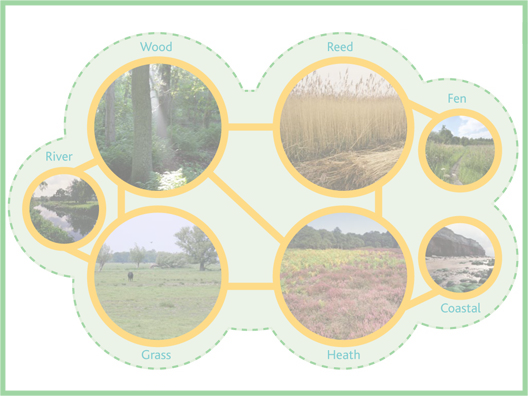
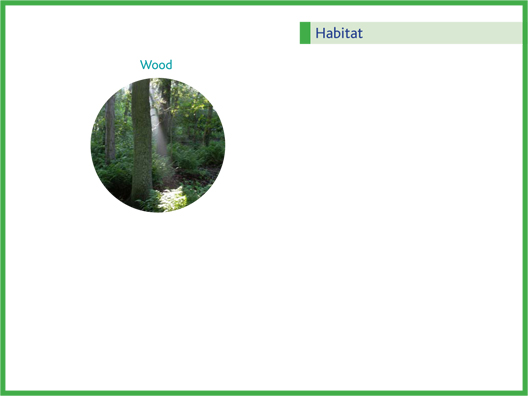
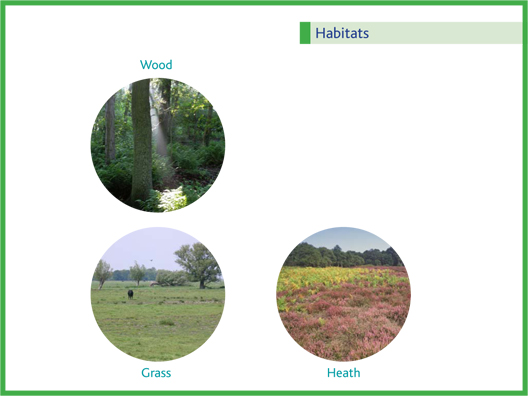
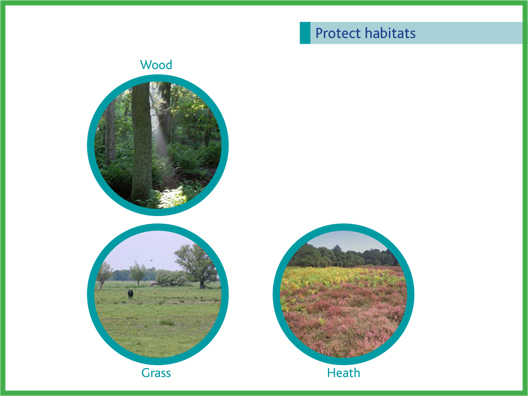
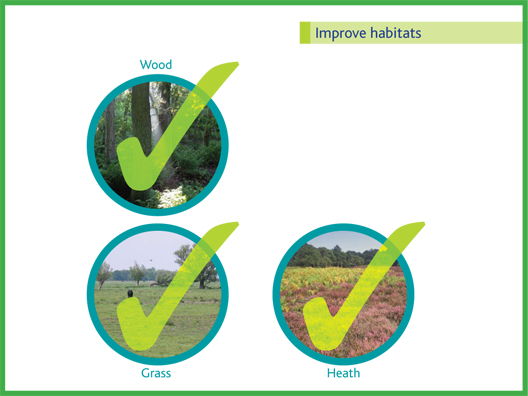
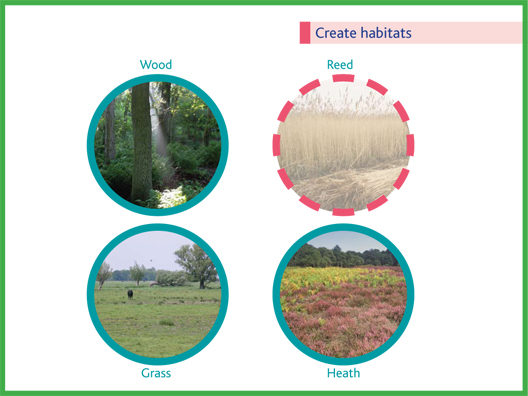
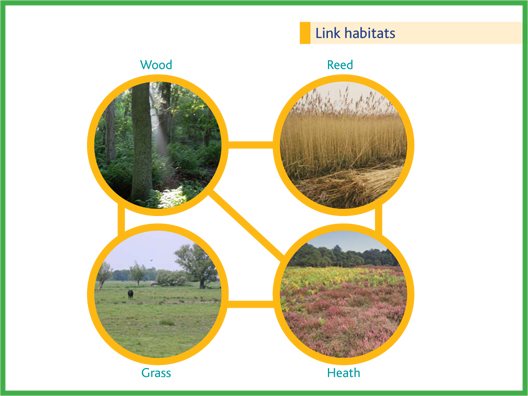
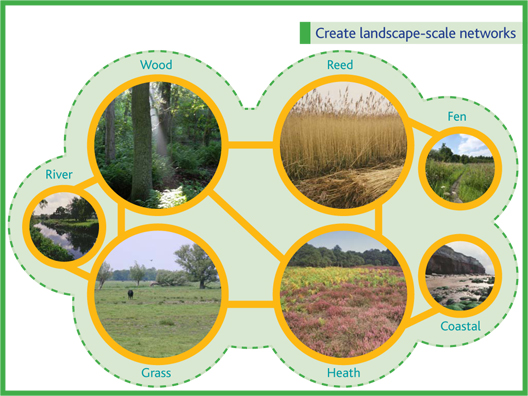

To begin to tackle any of these priorities we suggest that the initial point of contact should be the most appropriate biodiversity partnership
Alternatively, your project ideas could be discussed with the East of England Biodiversity Co-ordinator. For all contact details refer to this website.
Title page:
Habitat/species montage - various
Habitat type page:
Woodland scene - Andy Excell
Habitat types
Arable field margin, Halvergate, Suffolk—Steve Scott
Native woodland:
Main: Bonny Wood, Needham Market - Steve Aylwerd
Fly Agaric - Peter Wakely/NE
Dormouse - Bergt Lundberg/NE
Beech woodland - Robert Goodison/NE
Woodland sunbeam - Andy Excell
Woodland ride - Mike Addis
Bluebells - Mike Addis
Woodpasture & parkland:
Main: Woodpasture, Staverton, Suffolk —Steve Aylwerd
Captains Wood - Steve Aylwerd
Staverton - Steve Aylwerd
Stag beetle - 2010 Photo Library/NE
Lesser spotted woodpecker - 08A140JPG/NE
Pipestrelle - Fiona Quick/NE
Lowland meadow
Main: Blyth Meadow, Cranford - Steve Aylwerd
Adders tongue fern - Robert Goodison/NE
Bee /Natural England
Lowland calcareous grassland:
Main: Thorpe Meadows LNR, Peterborough —Peter Wakely
Chalkhill blue butterfly - Robert Goodison/NE
Pasque flower Barnack Hills Cambs - Gill Catton/NE
Lowland heath:
Main: Parsnip Heath, Sutton - Steve Aylwerd
Tunstall Common, Suffolk - Steve Aylwerd
Westleton Heath, Suffolk - Peter Wakely
Dartford Warbler /NE
Nightjar - Laurent Geslin/NE
Ant lion /Natural England
Fen:
Main: Valley Fen Roydon - Steve Aylwerd
Norfolk Hawker Dragonfly - WJ Furse/NE
Fen raft spider at Redgrave & Lopham Fen, Suffolk - Peter Wakely/NE
Swallowtail Butterfly - Douglas McNeill/NE
White spotted pinion moth - Nick Greatorix-Davies/NE
October reedbed - Mike Addis
Reedbed:
Main: Hen Reedbeds - Steve Aylwerd
Reed cutting at Bure Broads & Marshes, Norfolk - Peter Wakely
Reedbed & bittern - Mike Addis &\
Standing bittern Berndt Fischer/NE
Reed Leopard, Wicken Fen - Mark Skevington/NE
Coastal floodplain:
Main: Halvergate marshes, Suffolk - Steve Scott
Pink-footed goose/NE
Marsh harrier - BBC Wildlife - Markus Varesvuo
Lapwing 1999 - PN Watts/NE
Coastal habitats:
Main: Shingle Street, Steve Aylwerd
Shingle ridge, Blakeney, Norfolk - Peter Wakely
Saltmarsh, Blakeney - Peter Wakely;
Hunstanton Cliffs, Norfolk - Peter Wakely
Eroded mudflats off Mersea, Essex; - Peter Wakely
Eel grass 1JPG - Mark Iley/NE
Native oyster JPG - Mark Iley/NE
Lakes:
Main: Lake - Mike Addis
Benacre lake, Suffolk—Steve Scott
Eel - NE
Natterjack toad 2 - Peter Wakely/NE
Otter, Wildwood, Kent - Paul Glendell/NE
Water Vole - 2010 Photolibrary.com/NE
Connecting habitats:
Main: Pond at Redgrave and Lopham Fen - Andy Excell/NE;
River Wensum, Norfolk—Peter Wakely;
River Gipping - Steve Aylwerd
Arable field margin, Halvergate, Suffolk—Steve Scott
Lilypad DSC0236 - Mike Addis
Red-tipped cudweed - Mike Addis
Marine:
Main: Container ship off Felixstowe - Chris Gibson
Insets: Chop on the North Sea off Wallasea Island, Essex —Steve Scott
Red and green beadlet anemone, Lundy - Paul Glendall/NE
Harbour porpoise /NE
Pink sea fan /NE
Brownfield:
Main: Previously developed land in Thames Chase, Essex —Steve Scott
Ingrebourne mountain bike course. - Rob Barton
Black redstart /NE
Hedgehog - Jose Luis Gomez de Francisco/NE
How's it done page:
Orchard in winter —Nigel Russell, Natural England
Next steps page:
Kids running through bluebells - 106033/Forestry Commission
BAP:
Biodiversity Action Plan. In 1994 the UK launched its Biodiversity Action Plan (BAP) as the first formal step towards implementation of the Convention on Biological Diversity (CBD). In 2002 the England Biodiversity Strategy duly followed. Now the UK BAP comprises Species Action Plans (SAP’s) and Habitat Action Plans (HAP’s), all aimed at conserving and enhancing our most threatened biodiversity.
Biodiversity:
A term embracing the variety of life on Earth. Biodiversity is essential for sustaining the natural living systems or ecosystems that provide us with food, fuel, health, wealth, and other vital services.
Being part of this biodiversity humans have the power to protect or destroy it. Currently, our activities are reducing biodiversity at alarming rates. As these losses are irreversible, they impoverish us all and damage the life support systems we rely on. But we can prevent them.
Biological Diversity:
Following the UN’s Earth Summit in 1992 the UK, along with another 150 other signatories, ratified the Convention on Biological Diversity (CBD). This was the world’s first treaty providing a legal framework for biodiversity conservation.
Climate change:
The East of England is likely to experience the most extreme effects of climate change in the country. Consequently biodiversity here will be particularly at risk. Rises in sea levels and risks of seasonal flooding will lead to inundation; by contrast many parts of the East of England will also be at risk of water shortages (see entry on Water resources). As a result the range of some important species may be constricted, while some pest species may thrive
Create habitat:
Increase area of the habitat beyond its current extent. This includes the creation of lost habitat in areas where it formerly occurred. Wherever possible, habitat expansion should aim to link or extend existing areas of that particular habitat type.
Ecological network:
The harnessing of local conservation activity to exploit functional linkages to create a more strategic interconnected landscape.
Ecosystems:
The interlocking nature of biodiversity that encompasses land and soil, water and air. In effect the quality of biodiversity, both in terms of species and their habitats, determines the health of the natural world’s ecosystems.
An ecosystem’s strength is important, as the more robust a system is the more services it can deliver to us. For instance, flood attenuation occurs naturally in the floodplains where river systems have remained untouched. Thus protection of biodiversity aids the overall resilience of ecosystems, which duly offers more protection to society.
Ecosystem services:
This refers to qualitative functions of natural non-produced assets of land, water and air (including related ecosystems) and their biota. Experts currently recognise four categories of ecosystem services. The following lists provides samples of each type:
Provisioning services
- food (including seafood and game), crops, wild foods, and spices
- water
- pharmaceuticals, bio-chemicals, and industrial products
- energy (hydropower, biomass fuels)
Regulating services
- carbon sequestration and climate regulation
- waste decomposition and detoxification
- purification of water and air
- crop pollination
- pest and disease control
Supporting services
- nutrient dispersal and cycling
- seed dispersal
- primary production
Cultural services
- cultural, intellectual and spiritual inspiration
- recreational experiences (including ecotourism)
Financial state:
The need to reduce public spending in the UK is expected to limit the opportunities to continue to protect and develop the environment across the East of England. In order to contend with these tougher circumstances and respond to growing pressures on the environment a measure of prioritisation will need to be applied.
GI:
Green Infrastructure
HAP:
Habitat Action Plan
Infrastructure expansion:
Business activity ranging from industrialisation to services such as tourism and entertainment are expected to continue to expand throughout the East of England. Harnessed to this expansion will be a concomitant trend towards urbanisation.
IYB:
International Year of Biodiversity
Landscape-scale:
A ‘big-country’ approach to the creation of GI assets.
LAs:
Local Authorities
LBAPs:
Underpinning regional BAPs are more local plans, known as Local Biodiversity Action Plans (LBAPs). These plans represent the policy backdrop to enable county-level and local organisations to direct action to the habitats and species that are threatened and need most help in the UK. At the local level, biodiversity partnerships have developed their own biodiversity action plans setting out what is needed to deliver both national and local priorities. To date hundreds of these BAPs have been adopted across the East of England.
Maintain habitat:
Ensuring there is no loss in current habitat resource or quality, and that the physical processes required to maintain the habitats are operating.
Population growth:
As a result of economic growth the East of England population is expected to receive large numbers of incomers over the next 20 years and is consequently set to experience unprecedented growth in housing and associated infrastructure, farming etc. Consequently all types of habitat are under threat.
Restore habitat:
Restoration of those areas of a habitat that are deemed degraded in quality and the return of them to good condition, through positive management and/or cessation of damaging processes.
Societal preferences:
A number of factors influencing society preferences are having an impact on East of England habitats.
The health agenda is undoubtedly giving rise to increasing numbers of people accessing the countryside. If channeled correctly this is not a problem. However, in some cases where vulnerable BAP species are involved, this increased access can threaten their future.
Traffic-light system:
A three-tier system is used to flag a habitat type's status, with different colours representing different conditions. viz. Green indicates an expectation that targets will be met or exceeded; Amber shows targets might be met, or there is room for cautious optimism; while Red denotes that, given current knowledge, targets are not expected to be met.
Water resources:
This term refers to sources of water that are useful to humans and the ecosystem. Only 3% of all water on the planet is fresh. Of this over 2/3rds is tied up in glaciers and the icecaps, with virtually another third in ground water and less than 1% on the surface or in the air. This renewable resource is however steadily depleting.

